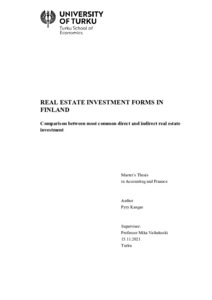REAL ESTATE INVESTMENT FORMS IN FINLAND : Comparison between most common direct and indirect real estate investment
Kangas, Pyry (2021-12-20)
REAL ESTATE INVESTMENT FORMS IN FINLAND : Comparison between most common direct and indirect real estate investment
Kangas, Pyry
(20.12.2021)
Julkaisu on tekijänoikeussäännösten alainen. Teosta voi lukea ja tulostaa henkilökohtaista käyttöä varten. Käyttö kaupallisiin tarkoituksiin on kielletty.
avoin
Julkaisun pysyvä osoite on:
https://urn.fi/URN:NBN:fi-fe2021122363192
https://urn.fi/URN:NBN:fi-fe2021122363192
Tiivistelmä
The purpose of this study is to examine the real estate market in Finland, available ways to invest into real estate, and how different real estate investment forms differ from each other. These include Indirect real estate investment through either publicly traded real estate companies, REIT’s, or special purpose investment trusts, and direct investments into real estate. This Thesis offers insight and information on the specific characteristics, classes, and investment means, and explores the tax exempt relatively new special investment funds as an alternative. The benefits and disadvantages of different types of real estate are studied as are the differences between the different investment forms.
As the real estates differ substantially due to their heterogeneity, different types of real estate and companies investing in them are difficult to compare. In Finland, there are large differences between regions, and the subsegments within them. To be able to compare two different property companies and their performance, you would need to know what the geographical regions and property types are. In the thesis, differences in legislation and characteristics are compared. The old problem of NAV variations continues and remains unsolved, although delistments of property companies have been near NAV.
The drivers for real estate total returns derive from two main components, cash flow and capital gains. In growth centres the cash flow has for a long time already been unable to reflect the value of the real estate, and the required return is satisfied with the capital gain component. The yield requirements are also historically low, and the overall growth rate is not sustainable in the long run.
One of the findings in the thesis is that investments into real estate in special investment funds have grown, whilst listed property companies have dwindled. This seems to specific to Finland, as the legislation for special investment funds is different. When compared to Nordic and European countries, the required rates of return for most real estate types are below average, meaning that the yield required is higher than on average, and investments are continuing. In some property segments such as office and retail, there is a market transition in demand.
As the real estates differ substantially due to their heterogeneity, different types of real estate and companies investing in them are difficult to compare. In Finland, there are large differences between regions, and the subsegments within them. To be able to compare two different property companies and their performance, you would need to know what the geographical regions and property types are. In the thesis, differences in legislation and characteristics are compared. The old problem of NAV variations continues and remains unsolved, although delistments of property companies have been near NAV.
The drivers for real estate total returns derive from two main components, cash flow and capital gains. In growth centres the cash flow has for a long time already been unable to reflect the value of the real estate, and the required return is satisfied with the capital gain component. The yield requirements are also historically low, and the overall growth rate is not sustainable in the long run.
One of the findings in the thesis is that investments into real estate in special investment funds have grown, whilst listed property companies have dwindled. This seems to specific to Finland, as the legislation for special investment funds is different. When compared to Nordic and European countries, the required rates of return for most real estate types are below average, meaning that the yield required is higher than on average, and investments are continuing. In some property segments such as office and retail, there is a market transition in demand.
